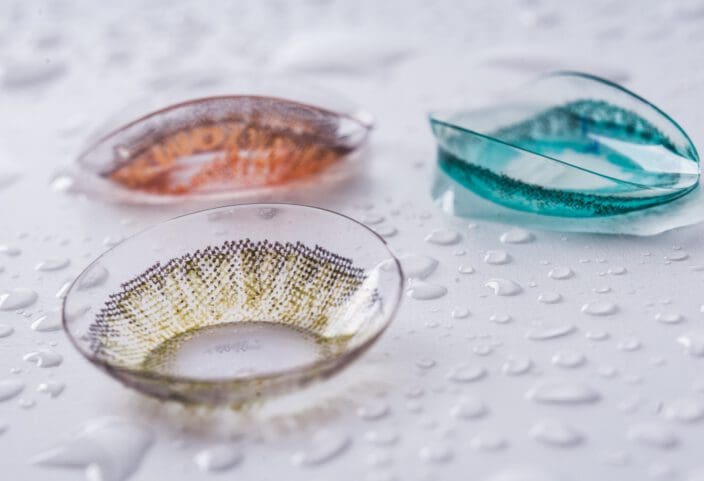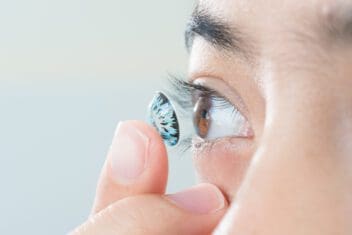Risks Involved With Colored Contact Lenses
Home / Understanding Contacts /
Last Updated:
Eye Infections and Possible Hazards

Some doctors report that eye-related injuries are more common around Halloween, and this is partially due to people wearing colored contact lenses that are not medically approved.
The issues related to some of these lenses can result in long-term vision problems. One teen had her cornea damaged from such a contact lens, resulting in partial blindness in one eye.
The FDA warns that wearing contact lenses can irritate the eyes and lead to pink eye (conjunctivitis), corneal infections, scratches on the cornea, possible impaired vision, and blindness. Allergic reactions are possible too.
Putting something into your eye can increase the odds for bacterial infections like keratitis. This can become serious and have irreversible consequences if not handled promptly and properly.
Colored contacts sit on top of your cornea just as other contact lenses do. As a result, they have many of the same possible risk factors.
Decorative contacts may be thicker or have more pigment than traditional contacts. They can therefore let less oxygen through into the eye. This can cause dry eyes and increase the risk for infection.
Decreased Vision Related to Colored Contact Lenses
Colored contacts that use an opaque tint, which is a tint that is not transparent, have color on the part that is designed to fit over the iris of the eye. This is the part of the eye that gives it the color. The middle of the lens is left clear for the pupil to be able to see through it openly.

Contacts can move around on your eyes, however. They don’t stay in just one place, especially when you blink. When this happens, the colored lens can move. Then, the “hole” in the center of the lens may not line up exactly with your pupil. Not only does this look unnatural as your true eye color is exposed underneath, but it can also impair your vision.
An opaque tint with a clear center can lead to decreased vision when the pupil expands due to low-light situations. This can make it more difficult to see out of colored contacts, especially at night.
As light decreases, your pupils get bigger to try and take in more light. Colored contacts only have so much room to allow your pupil to expand. The transparent center of the lens can only be so big. Your pupil will continue to expand, but your vision will be blocked by the colored portion of the contact.
Table of Contents
Colored contact lenses are specialized medical devices that need to be treated and worn with care.
Just like with regular contact lenses, wearing colored contacts can increase the odds for eye and corneal infections, scratches on the cornea, possible allergic reactions, impaired vision, and even potential blindness.
Colored contacts can slide around on the eye, which can impair vision. It can also make it clear that you’re wearing colored contacts when both your natural color and the colored contact are visible.
It is essential to get a prescription from an optometrist for colored contacts even if you don’t need them to correct your vision. Serious eye injuries can occur if colored contact lenses are used without doctor supervision.
Follow all directions and recommendations regarding purchasing, cleaning, wearing, storing, disposing of, and replacing your colored contact lenses. This can help to decrease the possible risks.
Minimizing Risks of Colored Contacts

All contacts, even plano colored contacts that do not correct for vision, are classified as medical devices by the FDA. They need to be approved and used only through a prescription.
Colored contacts need to be fitted to your eye specifically and then purchased through an FDA-approved source. Unapproved retailers selling colored contacts are doing so illegally. These non-prescription lenses can lead to serious complications, including impaired vision, eye infections, and blindness.
You deserve clear vision. We can help.
With 135+ locations and over 2.5 million procedures performed, our board-certified eye surgeons deliver results you can trust.
Your journey to better vision starts here.
When looking into colored contacts, you will need to have your eyes specifically measured and then obtain a customized prescription from an optometrist. Contacts that don’t fit your eyes properly drastically increase the odds for infections, ulcerations, and eye-related problems.
Here are some tips for preventing issues related to colored contacts:
- Get fitted for colored contacts from an optometrist and obtain a prescription.
- Buy your colored contacts from a source that requires a prescription and is approved by the FDA. Do not buy colored or decorative contacts from a beauty salon, convenience store, online retailer that doesn’t ask for a prescription, or street vendor.
- Use only colored contacts that are prescribed for you directly, and don’t share them with others.
- Practice good hygiene. Always wash your hands before touching your contacts or your eyes.
- Clean and store your colored contacts exactly as directed. Use only the specialized contact solution recommended by the contact manufacturer to clean and store your contacts.
- Replace your colored contacts at the scheduled times, and wear them only as directed. Take them out, dispose of them, and replace them when the manufacturer dictates.
- Take out your contacts immediately if you experience any discomfort, irritation, redness, or discharge in your eyes. Contact your eye care professional right away.
New Eyes for Special Occasions: Halloween Contacts & More

You can safely get color contact lenses, but there are other types of specialty contact lenses you should potentially avoid.
Halloween contact lenses can provide a spooky effect, perfecting the overall result of your most terrifying costume. You may be interested in glitter contact lenses for Christmas, or pastel contacts like lavender or pale blue for Easter.
Regardless of the type of specialty contact lenses you seek, it is important to work with a medical professional, such as your optometrist or ophthalmologist. Don’t purchase these lenses online or in a costume shop.
You may be able to find decorative or festive contacts at retailers like these:
- Halloween supply stores
- Costume shops
- Flea markets
- Vintage retailers
- Novelty stores
- Costume supply stores
But none of these are legitimate places to purchase any kind of contact lenses, even if they are not designed to correct your vision. In fact, many retailers may be selling them illegally.
In the United States, no retailer can legally sell contact lenses of any type without a prescription. Contact lenses are medical devices, according to the United States Food and Drug Administration (FDA). Even if these lenses are not designed to correct your vision, and only sit on top of your corneas and change the color of your irises, you need help from an optometrist or ophthalmologist to fit these contacts safely to the surface of your eye.
Despite this, there are many retailers, especially online, that will sell Halloween contact lenses or other specialty decorative, festive, or color contacts without requiring a prescription. Here are some suggestions to avoid harm caused by the wrong kind of Halloween contacts:
- Get an exam to fit your eyes for contacts, even if you wear contacts to correct your vision normally. This will allow your eye doctor make appropriate recommendations.
- Get a valid prescription and purchase Halloween or festive contact lenses from a retailer who asks for a prescription.
- Follow the care instructions for the specialty lenses, and keep them in a new, clean, separate case from your standard contact lenses.
- Never share these specialty lenses with someone else.
- Get follow-up exams as recommended by your optometrist or ophthalmologist.
If you notice any problems with your lenses, immediately report them. These may include:
- A scratch or cut on the cornea, or the top layer of your eye.
- Watery eyes, especially while you are wearing the contacts.
- Poor, blurry, doubled, or decreased vision.
- Problems seeing at night.
- Eye pain while wearing the lenses.
- Redness, itchiness, and dryness in your eyes, even after you take the lenses out.
- Swelling in or around your eyes.
- Discharge from your eyes, even after you take the lenses out.
These symptoms all suggest an eye infection, which is more likely to occur if you get Halloween or specialty lenses from a store that is not a safe, legal retailer for contacts
Popular Brands
Many established brands make colored contacts. Ask your eye doctor about these lenses. Since they are medically approved, they are considered safe.
- Air Optix Colors: Alcon creates these monthly contacts in a variety of colors, such as true sapphire, gray, and amethyst.
- FreshLook ColorBlends: These popular lenses subtly enhance the natural color of your eyes. They are available at a variety of retailers with a prescription.
- Dailies Colors: Another option from Alcon, these colored contacts come as daily disposable lenses.
Colored contacts can be used safely if all directions and recommendations by your optometrist and the FDA-approved manufacturer are followed exactly.
Even when used as directed, however, colored contacts can have some risks and may not be suitable for everyone. Talk to your eye doctor to see if they will work for you.
You deserve clear vision. We can help.
With 135+ locations and over 2.5 million procedures performed, our board-certified eye surgeons deliver results you can trust.
Your journey to better vision starts here.
References
- Contact Lens Risks. (September 2018). U.S. Food and Drug Administration (FDA).
- Are Colored Contact Lenses for Halloween Safe? (September 2018). American Academy of Ophthalmology (AAO).
- Color Contact Lenses: Which Are Best for You? (April 2019). All About Vision.
- ‘Colored’ and Decorative Contact Lenses: A Prescription is a Must. (February 2016). U.S. Food and Drug Administration (FDA).
- Halloween Contact Lenses and Other Special-Effect Contacts. (October 2018). All About Vision.
- If You Want to Wear Colored Contact Lenses, FDA Has a Warning. (October 2018). Forbes.
- List of Contact Lenses. (April 2019). U.S. Food and Drug Administration (FDA).
- Decorative Contact Lenses for Halloween and More. (October 2019). United States Food and Drug Administration (FDA).
- Halloween Hazard: Never Buy Decorative Contact Lenses Without a Prescription. (September 2018). American Academy of Ophthalmology (AAO).
This content is for informational purposes only. It may have been reviewed by a licensed physician, but is not intended to serve as a substitute for professional medical advice. Always consult your healthcare provider with any health concerns. For more, read our Privacy Policy and Editorial Policy.
